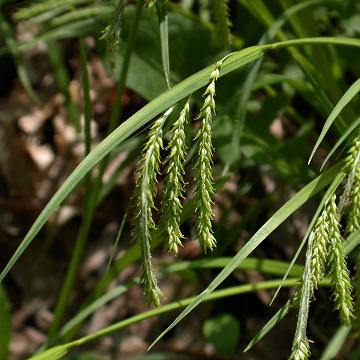

Carex prasina - (image 1 of 4)
Taxonomy
Family: Cyperaceae
Section Hymenochlaenae
Habitat
Moist to wet woods and streambanks.
Associates
Distribution
Quebec and ME west to MI, south to SC, GA, and AL.
Morphology
Tufted perennial to 80 cm; brown or greenish as the base; leaves 3-5 mm wide; sheaths smooth; terminal spike either staminate or with a few perigynia near the tip; pistillate spikes 2-4, cylindric, 2-5 cm long and 5 mm thick, curved or nodding; lower peduncles long, the upper shorter; upper bract sheathless or nearly so; pistillate scales shorter than the perigynia with a short, sharp, slender tip; perigynia angled at the lateral ribs but otherwise nerveless; 2.9-4.2 mm, trigonous, tapering to an acute beak; stigmas 3; achene trigonous.
Notes
Fruiting late May to July
Wetland indicator: OBL
The overall appearance of this sedge is like a robust version of C. gracillima. Also called Leek Sedge because of the color of the foliage.
This species was recently used to test whether or not optimal abiotic environmental factors determine the distribution of some plants. Under controlled greenhouse conditions C. prasina exhibited higher leaf chlorophyll content on soils with high organic matter, yet in the field the greatest occurrence of the species tended to occur on soils with lower organic matter. This suggests that biotic factors, such as competition or dispersal limitation, could be influencing the distribution of the species to a greater extent than optimal edaphic factors.
References
Flinn K.M., M.J. Waterway and M.J. Lechowicz. 2010. Disjunct performance and distribution in the sedge Carex prasina.
Oecologia 163(1).
Gleason, Henry A. and A. Cronquist. 1991. Manual of Vascular Plants of
Northeastern United States and Adjacent Canada. Second Ed.
The New York Botanical Garden. Bronx, NY
Swink, F. and G. Wilhelm. 1994. Plants of the Chicago Region.
Indiana Academy of Science. The Morton Arboretum. Lisle, Illinois.
|
© Michael Hough 2010 |